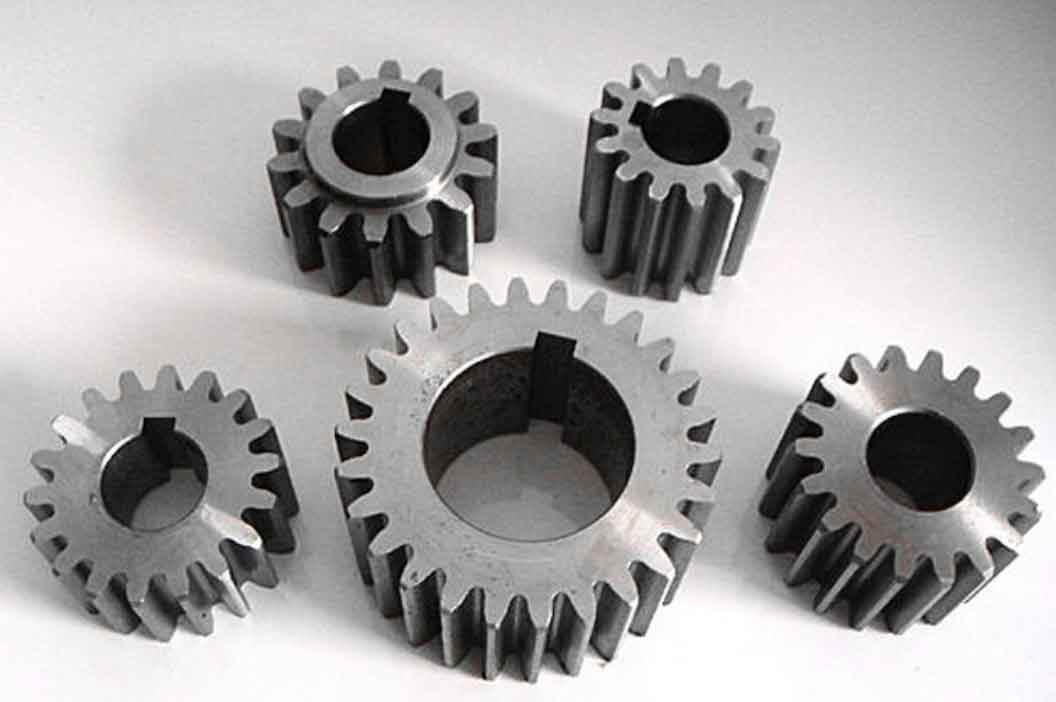Abstract
In the pursuit of reducing the forming load and enhancing the precision of spur gear manufacturing, this study proposes a novel two-step cold forging process that integrates inward flow and mandrel exchange techniques. Traditional closed-die precision forging often encounters challenges such as sharp increases in forming load, uneven metal flow, and stress concentration, leading to reduced mold lifespan and compromised gear quality. By leveraging the synergistic effects of inward flow (to promote radial material distribution) and mandrel exchange (to mitigate abrupt load surges), this research establishes a three-dimensional finite element model using DEFORM-3D software. Simulations reveal that the coupled method reduces the final forging load by approximately 50% compared to conventional methods, while ensuring uniform strain distribution and complete tooth profile filling. Experimental validation further confirms the feasibility of this approach, offering significant implications for industrial applications of spur gear production.

1. Introduction
Spur gear, as one of the most widely used transmission components, demand high precision, durability, and cost-efficiency in manufacturing. Traditional methods, such as “forging blanking—machining,” suffer from low material utilization, prolonged production cycles, and disrupted metal flow lines, which degrade mechanical properties. To address these limitations, precision forging has emerged as a promising alternative, enabling near-net-shape production with enhanced material integrity and reduced post-processing.
However, the complex geometry of spur gear—characterized by intricate tooth profiles and high aspect ratios—poses significant challenges in achieving uniform material flow and minimizing forming loads. Previous studies have explored techniques like open-die forging and multi-stage forming, yet issues such as excessive die wear and incomplete tooth filling persist. This study introduces a coupled inward flow and mandrel exchange method, aiming to optimize the cold forging process for spur gear through numerical simulation and experimental validation.
2. Methodology
2.1 Coupled Inward Flow and Mandrel Exchange Process
The proposed two-step forging process comprises:
- Pre-forging: A preform with end-face grooves is created using a convex anvil block (Figure 1a). This step facilitates inward material flow, reducing radial resistance.
- Final forging: A smaller-diameter mandrel and flat anvil block replace the pre-forging tools (Figure 1b). This modification allows unrestricted material flow into tooth cavities while preventing load spikes.
Table 1: Key Parameters of the Spur Gear Model
| Parameter | Value |
|---|---|
| Number of teeth (Z) | 18 |
| Module (m) | 1.5 mm |
| Pressure angle (α) | 20° |
| Inner diameter (d) | 11.5 mm |
| Material | AISI-1045 (cold) |
2.2 Finite Element Modeling
A 3D finite element model was developed in DEFORM-3D, considering symmetry to reduce computational costs (1/36 of the gear geometry). Key settings included:
- Material properties: Rigid dies vs. plastic workpiece (AISI-1045).
- Friction: Shear friction model with a coefficient of 0.12.
- Mesh: Tetrahedral elements for the billet.
3. Results and Discussion
3.1 Metal Flow and Velocity Distribution
Figure 2 illustrates the deformation and velocity fields during pre-forging (Step 1) and final forging (Step 2). Key observations include:
- Pre-forging (Step 80): Material flows radially at 1.68 mm/s due to contact with the convex anvil, ensuring rapid cavity filling.
- Final forging (Step 100): After mandrel exchange, material redistributes into tooth cavities and central grooves at 4.81 mm/s, leaving minimal unfilled space for subsequent machining.
Table 2: Velocity Comparison Across Forging Stages
| Stage | Radial Flow (mm/s) | Axial Flow (mm/s) |
|---|---|---|
| Pre-forging | 1.68 | 0.92 |
| Final forging | 4.81 | 1.59 |
3.2 Strain Distribution Analysis
Figure 3 compares strain fields for three anvil designs (Type A, B, C). Results highlight:
- Type A: Sharp edges caused stress concentration, leading to non-uniform strain (5.73 mm/mm).
- Type B: Increased edge angles (30°→55°) reduced stress peaks, improving strain uniformity (14.2 mm/mm).
- Type C: Rounded edges eliminated stress concentration, achieving homogeneous strain (7.37 mm/mm).
Table 3: Strain Uniformity Across Anvil Types
| Anvil Type | Max Strain (mm/mm) | Uniformity Index |
|---|---|---|
| A | 5.73 | Low |
| B | 14.2 | Moderate |
| C | 7.37 | High |
3.3 Forming Load Reduction
Figure 4 contrasts load-stroke curves between traditional closed-die forging and the coupled method:
- Traditional process: Load surges from 5.47 kN to 9.03 kN during final stages, risking die failure.
- Coupled method: Final load stabilizes at 4.6 kN (50% reduction), with pre-forging loads 30% lower due to enhanced radial flow.
Table 4: Load Comparison (kN)
| Process | Pre-forging Load | Final Forging Load |
|---|---|---|
| Traditional | 5.47 | 9.03 |
| Coupled Method | 4.6 | 4.6 |
4. Experimental Validation
Physical trials on a 1000 kN hydraulic press corroborated simulation results (Figure 5). The final spur gear exhibited:
- Complete tooth profiles with minimal flash.
- Uniform inward flow channels, eliminating post-forging machining.
- Consistent load profiles, validating DEFORM-3D predictions.
5. Conclusion
- Mandrel exchange in final forging prevents load spikes by enabling bidirectional material flow (tooth cavities + central grooves).
- Anvil design optimization: Type C (rounded edges) ensures uniform strain distribution and prolongs die life.
- Efficiency gains: The coupled method reduces forming loads by 50% and average loads by 30%, revolutionizing spur gear production.
This study underscores the potential of numerical simulation in advancing cold forging technologies, offering a blueprint for high-precision, low-cost spur gear manufacturing.
